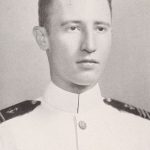 About the author: Carter Berkeley Simpson (November 3, 1915 — December 31, 1944), Captain, USMC. His USNA Virtual Memorial Hall Page contains his obituary:
About the author: Carter Berkeley Simpson (November 3, 1915 — December 31, 1944), Captain, USMC. His USNA Virtual Memorial Hall Page contains his obituary:
Carter Berkeley Simpson was born in Glenn Springs, South Carolina on November 3, 1915 to Richard Caspar Simpson and Mary Randolph Spotswood Berkeley. He attended Wofford College and graduated from the U.S. Naval Academy at Annapolis, Maryland in 1939. He earned a commission to the United States Marine Corps and served as an officer stationed in the Philippines during World War II. He commanded troops on Bataan as a First Lieutenant and served with Company M, Third Battalion, Fourth Marine Regiment (detached) as a member of a Navy Bluejacket-Marine Battalion in the defense of Bataan from December 28, 1941 to April 3, 1942. In this capacity, he served with an anti-aircraft battery which was not able to be hidden from observation and was thus forced to endure aerial bombardments. From January 23 to January 31, 1942, he served with a composite Bluejacket-Marine Battalion in order to drive off an enemy detachment which threatened Naval establishments at Miravalis in the Philippines. Simpson took control of several mixed units and thereby helped in successfully isolating the enemy force on Longoskawayan Point, for which he was posthumously awarded the Navy Cross by the President of the United States.
After the fall of Bataan, Simpson served on Corregidor until its surrender to the Japanese on May 6, 1942, at which time he became a prisoner of war and was interned in the Philippines in a Japanese POW camp from June 1942 until the end of 1944. He was among the POWs who were put onto the hellship Oryoku Maru for transport to Japan; the ship was sunk by American torpedoes. Although he survived, he was recaptured when he made it to shore and subsequently died of exposure and starvation on December 31, 1944. He was a captain by this time. A memorial marker stands in his honor at Arlington National Cemetery, and in 1969 his brother John Wistar Simpson organized an endowed scholarship fund at Wofford College to commemorate Carter.
About the diary: The same memorial page contains this brief item:
Carter somehow managed to write a diary of his wartime experiences, and also somehow ensure it survived the war. It is long and detailed and truly a treasure.
It can be gleaned from the initial pages of the diary that it was written sixteen months after the start of World War II in the Philippines, or roughly April, 1943. The linked diary is a typescript. It retroactively begins on December 8, 1941, and the final entry is dated October 12, 1944, or two months before the author’s death.
On page 96 of the typescript, at the top of the page, there is a series of hand-written notations, including the following: “this copied from USMC Research Center selective pages” and “Carter B. Simpson 1st Lt USMC Diary Dec 8 41 — Oct 12 44 orig is at Univ of VA lib.”
Entries from December 8, 1941 to May 8, 1942 are written in semi-digest form for the first half of the diary; starting on June 10, 1944 until the final entry on October 12, 1944, the entries are on a daily basis. The hand-written annotations above suggest that there may be an untyped series of entries from May 8, 1942 to June 9, 1944 that have not been transcribed and made available to the public. For ease of reading, the Philippine Diary Project has divided up the early entries on the basis of specifically mentioned dates: e.g. if a specific day is mentioned, then the material for that day appears as a separate entry. When this isn’t possible, then a range of dates is used.